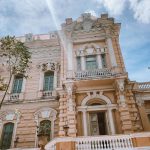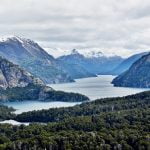I spent two days with a local family on the floating island of Uros. For many centuries, the Uru people have been building their homes on reed rafts in the middle of Lake Titicaca. Let’s visit them together!
Содержание
How to Get to the Uros Islands in Peru
The floating islands are situated in Peru, on Lake Titicaca. The nearest city, Puno, is about 5 km away from Uros.
There’s no public transport to the islands – the residents have their own boats.

Option #1 – Take a Tour from Puno
Cheap tours depart daily from Puno (10 soles, or 4 dollars). The islands change constantly so that all families can benefit from tourism. You’ll get a short tour and be led to a souvenir shop.
- Pros: opportunity for colorful photos; low price; the tour only takes 2-3 hours.
- Cons: all money goes to the agency in Puno, and Uros residents feel like monkeys in a zoo. It feels artificial, and there’s pushy souvenir selling (which is understandable).
Option #2 – Take a Combined Tour to Uros and Taquile Islands
All tours to Taquile Island include a visit to Uros. It was interesting, and we were treated with freshly fried dough. My first tour was much shorter. The island itself is 15 km away from the shore. It clearly relies on tourists. However, people live there too: they even managed to grow potatoes!
- Pros: a more interesting tour.
- Cons: prices for souvenirs and boat rides are higher, so even less tourists support these families.
Option #3 – Spend a Night on the Island [my choice]
In my opinion, this is the best way to experience the islands and is the most fair to the Uros residents. Transportation, accommodation, food are provided by the Uru people themselves, not some random company.
A lakeside cabin costs from 40 soles ($10) to $150 per night. You can book it on Booking.com or Airbnb. There are very comfortable hotels, and simpler ones – choose according to your taste!
My hotel was called Urosfood & Titicaca Lodge. You can book directly with the owner, Nicanor, at +51942256841.
Bring toilet paper, water, and snacks from the mainland. Everything there is sold at triple the price.
Option #4 – Go on Your Own Adventure
Uros is a very touristy place, and you’re unlikely to find a family living traditionally there. But if you want to explore the archipelago at your own pace, you can rent a kayak – Uros is only 5 km from the shore. Instead of a hotel, bring a tent, and ask to camp on any island you like. Or rent a cabin for a few days and ask the owner to take you to the least touristy spots.
In general, the key to any adventure is knowing the language and being able to connect with people.
How Much Does a Trip to the Uros Islands of Titicaca Cost
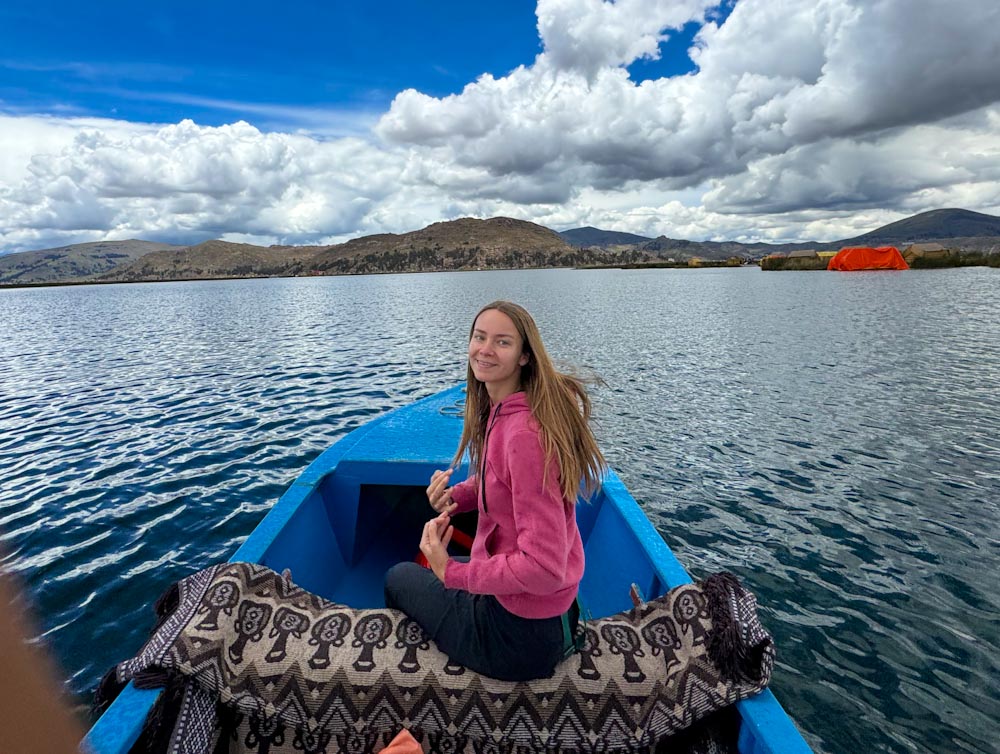
- Tour from Puno to Uros – 10 soles ($2.5) + 8 soles ($2) entrance fee to the islands;
- Tour from Puno to Uros and Taquile Islands – 58 soles ($15), all entrance fees included;
- 2 days/ 1 night on the island – from $27 to $50 for the whole experience. This includes: Hotel – from 40 soles ($11). Round-trip boat ride 30 soles ($8). Taxi to the far pier round trip – another $8, but you can take a cheaper tuk-tuk. Boat trip around the islands costs 50 soles ($13). Reed boat ride – 10 soles ($2.5). Lunch – 25 soles ($6.5). Entrance ticket to the Uros archipelago – 8 soles.
Fun facts about Uros islands on Titicaca lake
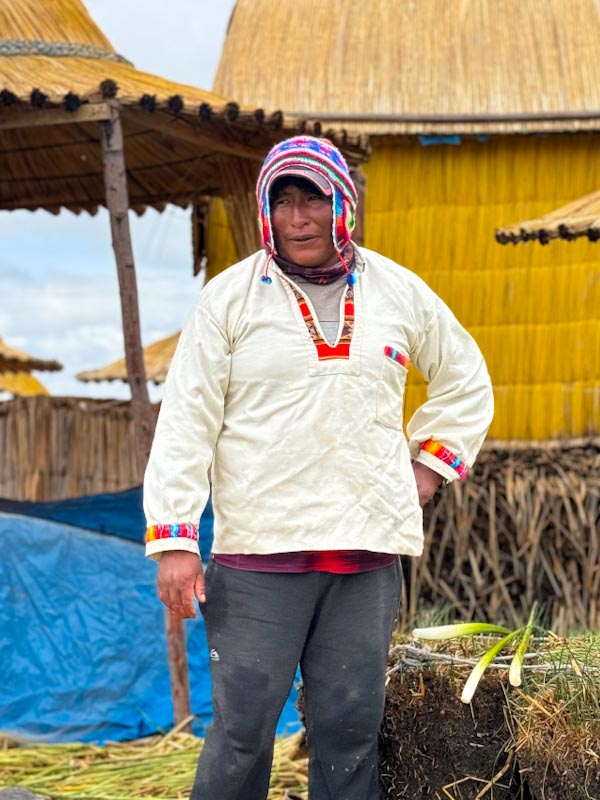
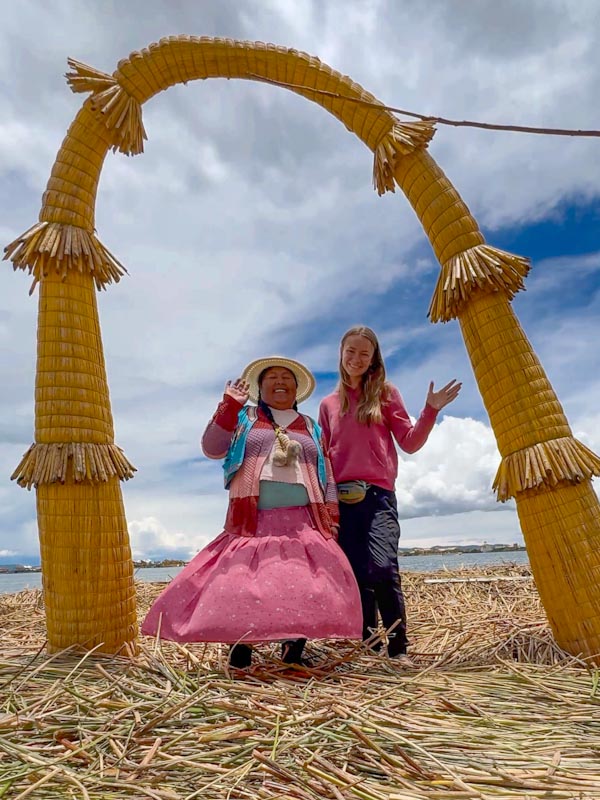
- The Uru are an ancient people who emerged on Lake Titicaca long before the Incas arrived. They call themselves the “people of the water.” Nowadays, the Uru live on the reed rafts of Uros, as well as in the Desaguadero River area and on the shores of the dried-up Lake Poopó in Bolivia.
- The Uru language is nearly forgotten. The Uros adopted the language of their Aymara neighbors with whom they traded and intermarried, and during the Inca Empire, they learned Quechua. Nowadays, they also speak Spanish. In 2004, there were only two people left who spoke Uru.
- How many people live on the floating islands? There are a total of 120 islands in the Uros system, where approximately 270 families, or 2000 people, live. The population of the Uros islands is declining, and there are two reasons for that. Firstly, there’s much less fish in the river than before. Secondly, the youth is leaving for cities to get an education, hoping for a better future.
- Previously, the islands were in the middle of the lake, 20 km from the shore. However, in 1986, a strong storm hit Lake Titicaca, and most Uru moved to a safer place closer to the shore. Now the floating islands are 5 km from Puno, and only some families continue to live 15 kilometers from the shore.
- Why do the Uru live on reed islands? 500 years ago, the Uru built reed islands for safety reasons. If enemies came to the lake, they could simply sail away and hide with their families from danger. More about it in this BBC Travel article.
- “Uru” in the Quechua language means “timid, hiding.” Ironically, now hundreds of tourists visit the timid Uru every day. People continue to live on the islands according to tradition. But most likely, this is the last generation of true Uru – living on a floating island isn’t easy.
My hotel on the floating island of Uros
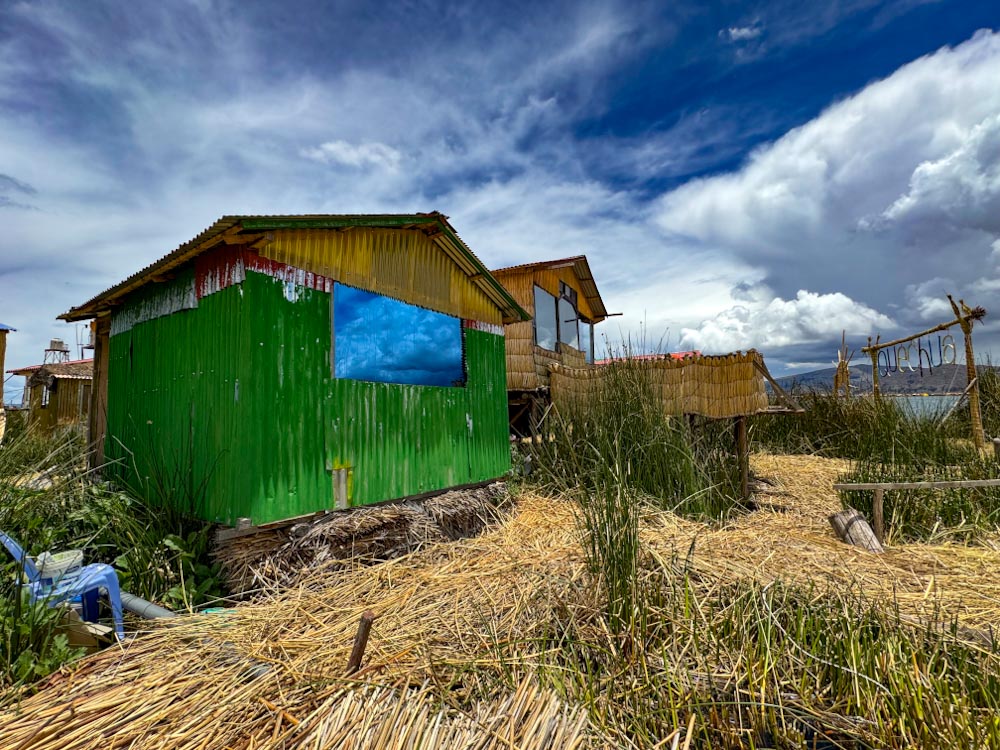
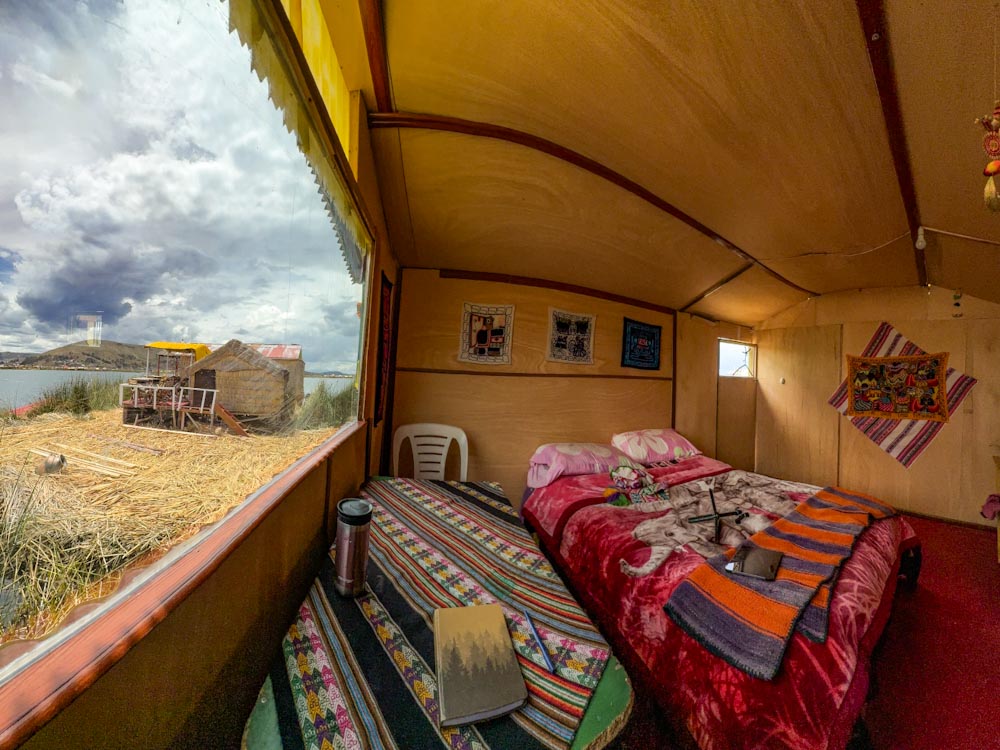
I booked a hotel on Booking.com, it cost me only $12. To get there, I had to take a taxi to the far pier and then ride a boat for about twenty minutes. All transportation was organized by the hotel owner.
Walking on the island felt strange, and the soft straw created a feeling of instability. I was given this little house: it looked no-so-attractive from the outside but was very cozy inside. Just look at that view!
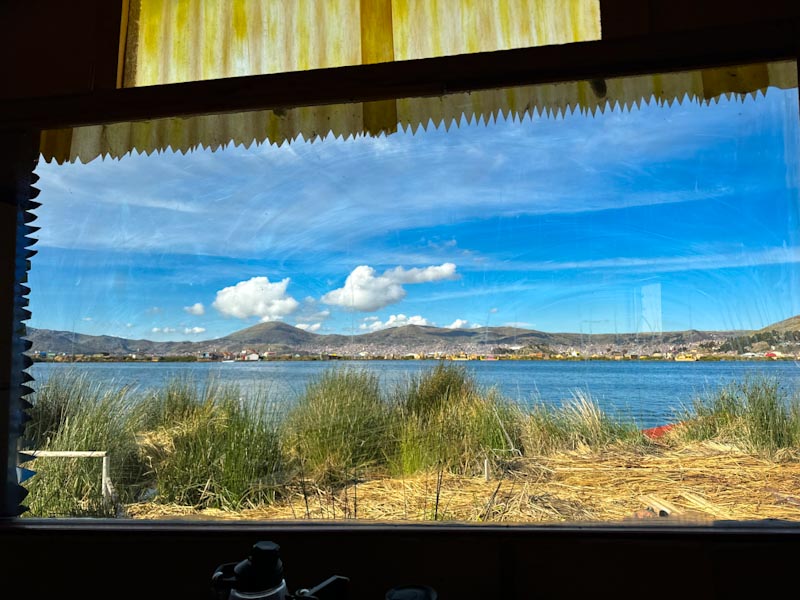
There were sockets, electricity, and a comfortable bed with ten warm blankets. Titicaca is at an altitude of 3800 meters, and nights there are cold.
The toilet was outside, one for the whole island. There was even a shower with warm water, heated by solar panels.
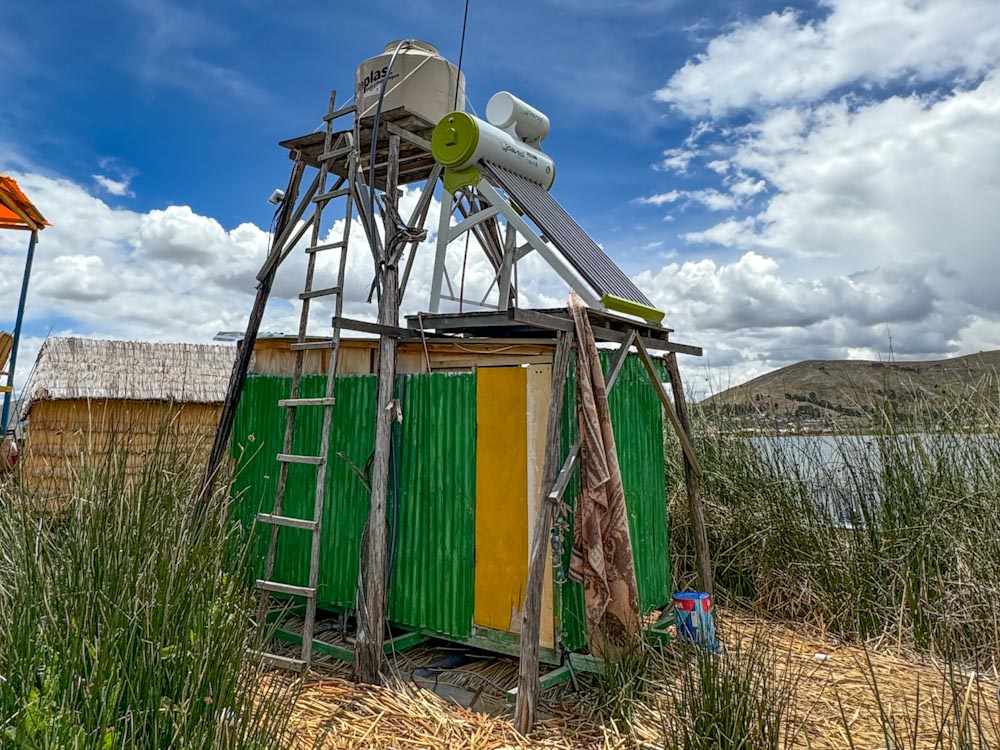
The hotel owner can prepare lunch. It costs 25 soles ($6.5) – that’s the standard price for tourist places in Peru. You can find lunch in town for 10-15 soles. But this freshly caught trout was delicious!
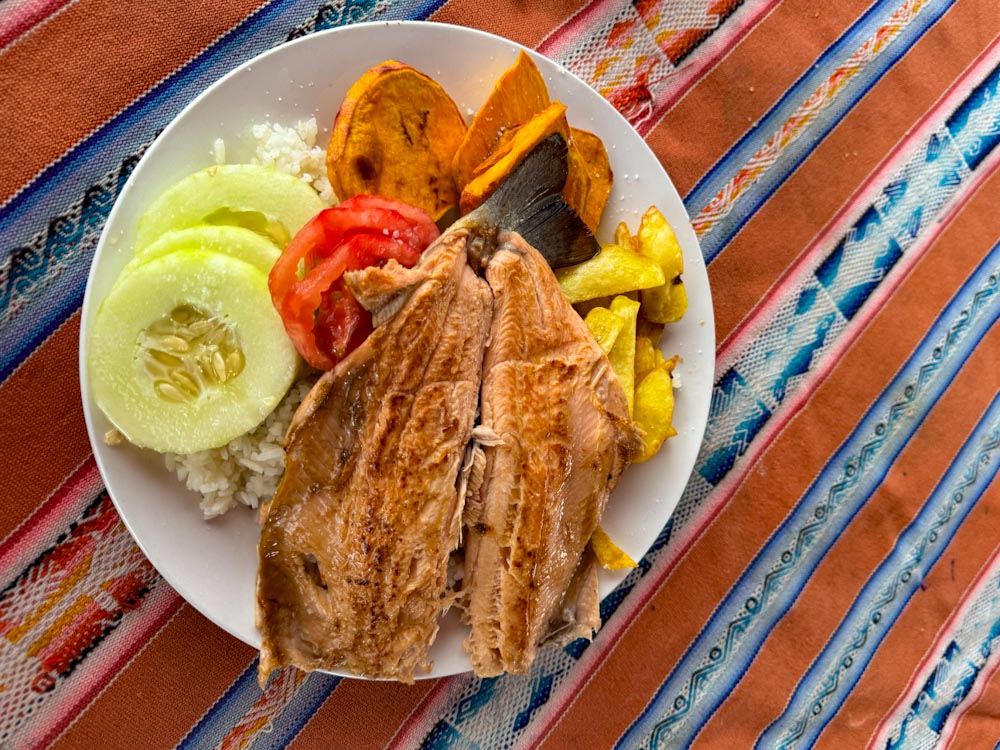
Exploring the Uros archipelago by boat
The hotel owner offered me a boat tour. It seemed pricey, but I decided to give it a try. Instead of touristy islands with shows, he took me almost around the entire archipelago. I was able to see ordinary families preparing food and doing laundry. Although they have abandoned many traditions, life on the floating islands continues.
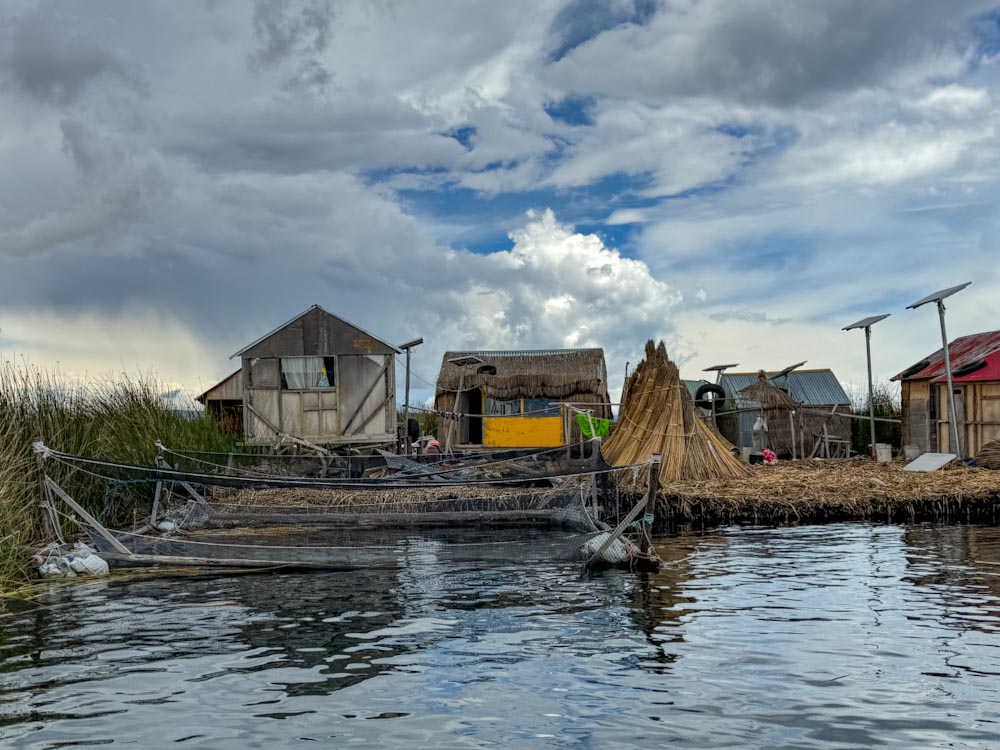
This is the elementary school with 60 children studying there. In the morning, a boat picks up students from the islands and then drops them back. Besides the elementary school, there’s a kindergarten on Uros where 25 children attend, and a middle school with only 12 children.
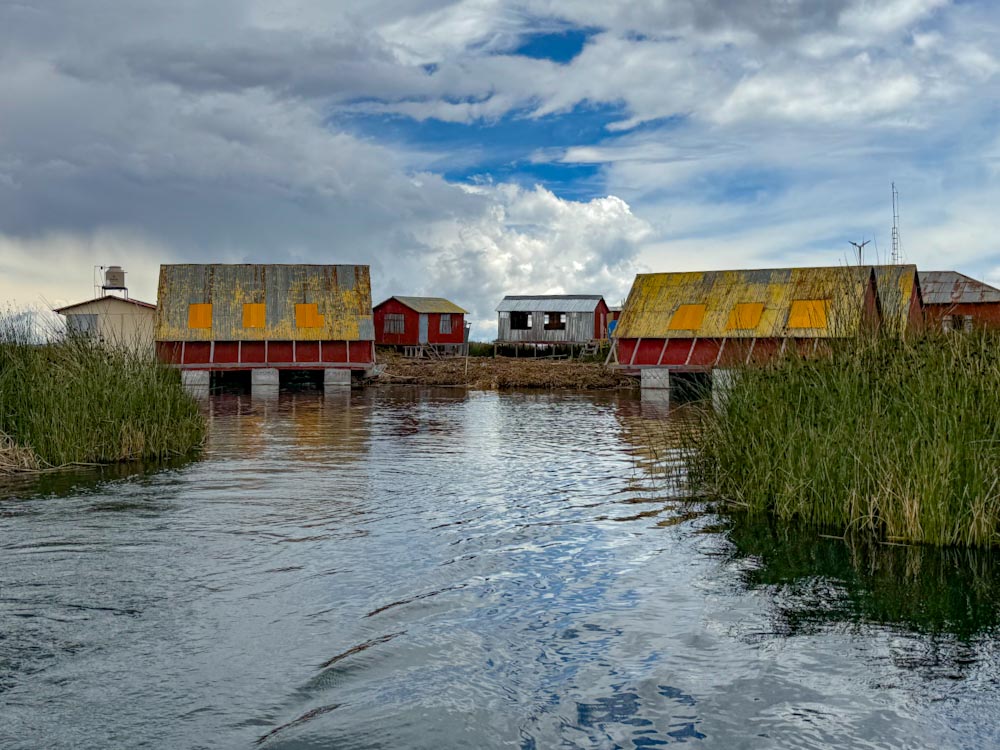
On a separate island, probably standing on some foundation, there is a Seventh-day Adventist church school. The Uru themselves don’t take religion seriously and believe more in Pachamama. These beliefs are reflected in their traditional crafts.
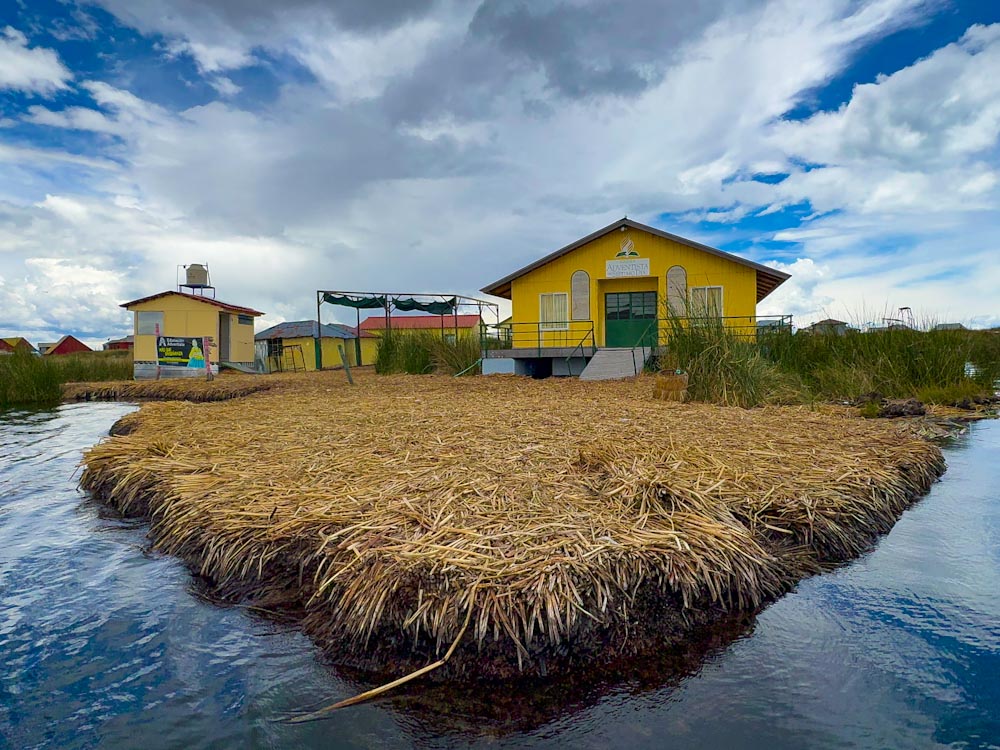
Visiting the show on Uros Islands
After a long walk along the archipelago, I was finally dropped off at a small island. There, tourists are given a presentation on Uros culture, and then offered souvenirs for purchase.
The islanders (and generally residents of Lake Titicaca) seemed very reserved to me; it’s hard to strike up a conversation with them. They have prepared information, but they answer additional questions briefly. Nevertheless, the talk was interesting.
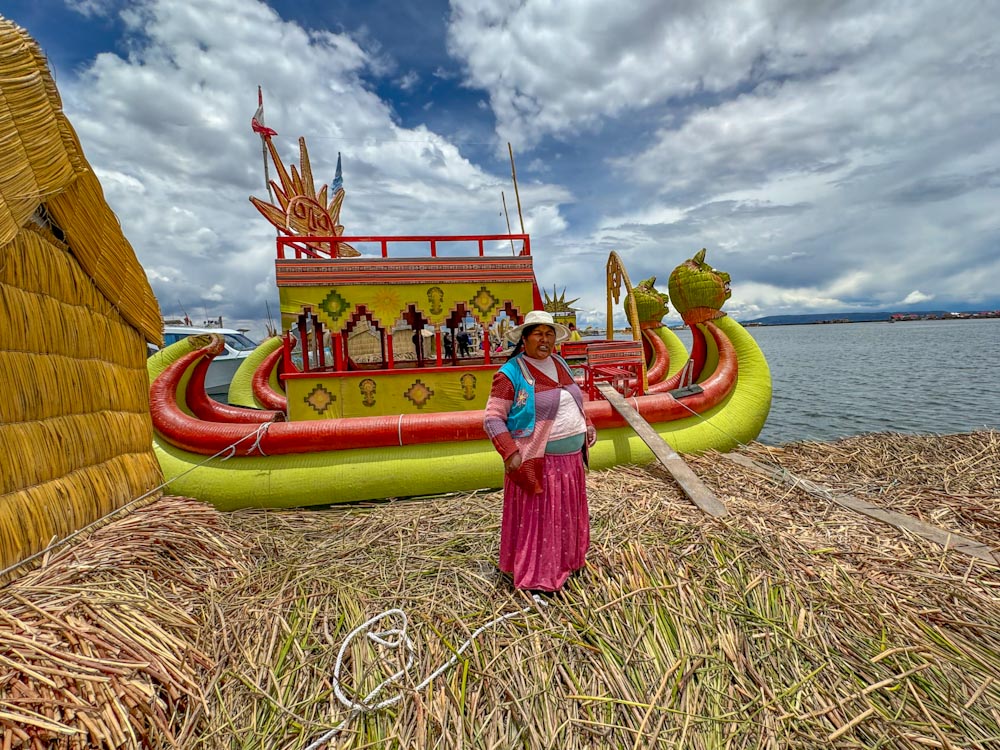
How the Uru build their floating islands
The Uru construct islands, houses, and boats from the totora reed. Initially, they take the compressed part where the reed roots are. It’s called “khili.” The thickness of this layer is 1.5-2 meters, and it forms the basis of the island. It’s harvested 10 km from Puno.
Fresh reeds are placed on top of the platform. First, they lay one layer, tamp it down for several days, then place the second layer perpendicular. They continue until the island reaches the desired thickness, at least 3 meters.
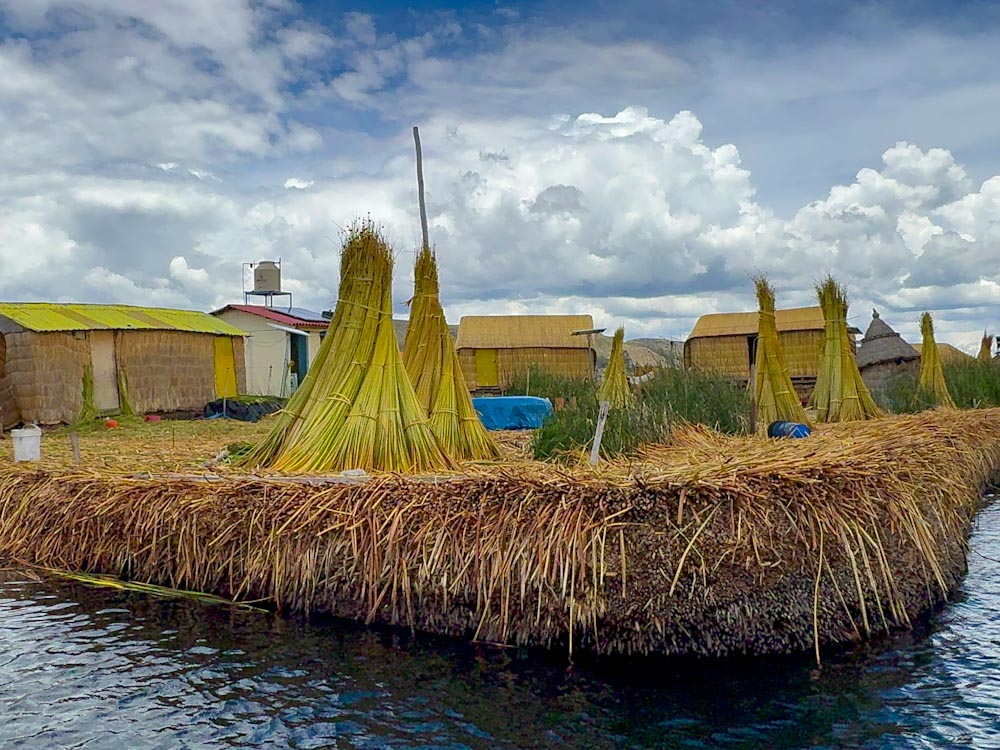
The reeds are regularly added, about every two weeks during the rainy season and once a month during the dry season. The bottom layer rots, so there’s a smell of decaying reeds on the islands. It’s noticeable but not too unpleasant.
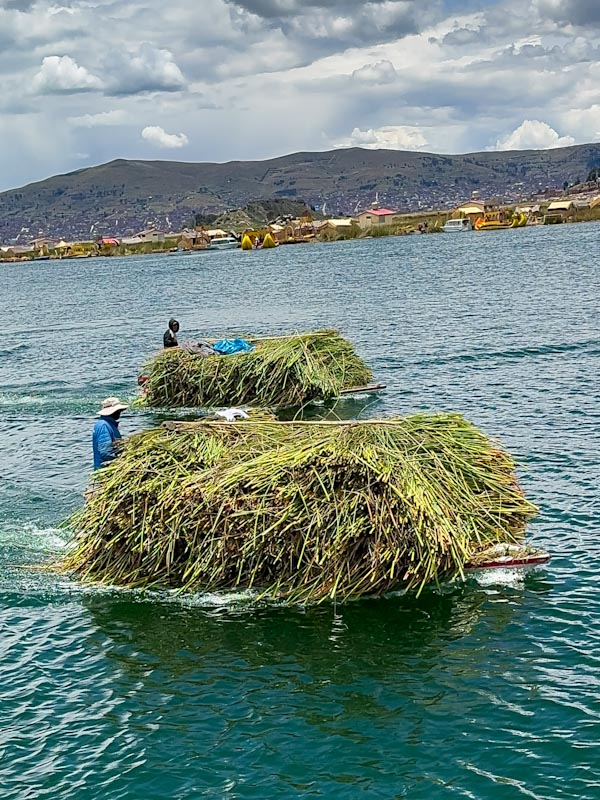
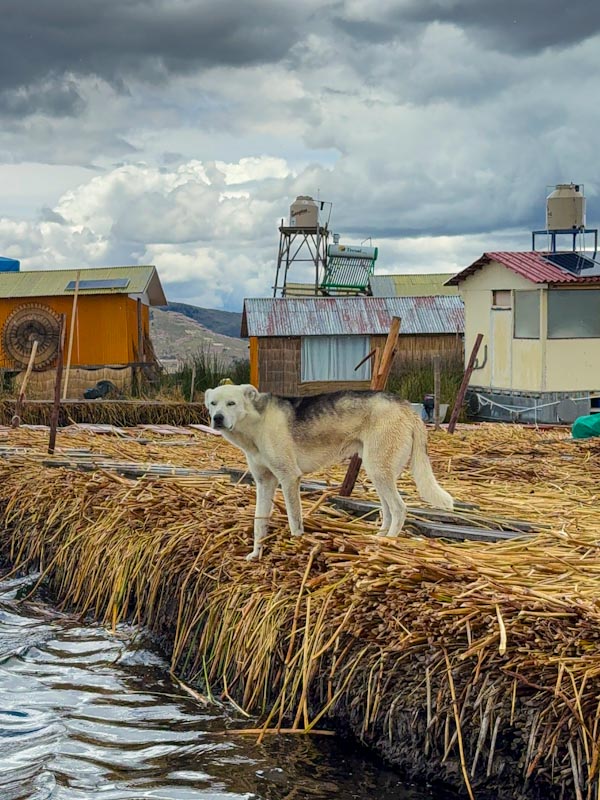
An anchor is attached to the island—a long pole—to keep it from drifting on the lake.
The lifespan of such an island is 25-30 years. Then the reeds completely rot, water starts seeping through, and a new island needs to be built. It takes about a year and a half to build one.
The average width of the island is 30 meters. It can accommodate 2-3 families.
Each island has an observation tower. It used to be used to communicate with other families and monitor safety.
What their houses look like
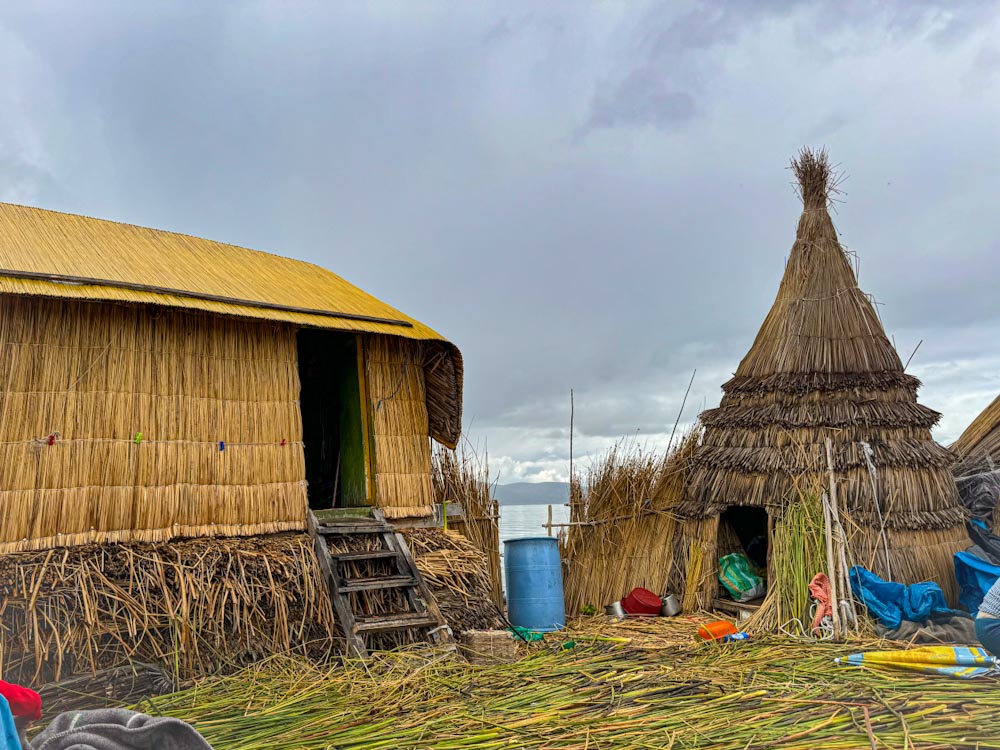
Houses are built on an additional layer of reeds about a meter high.
Previously, only reeds were used for building homes. They were laid out in a hut-like form—like in the photo above—and tied with ropes twisted from the same plant. Over time, the shape of the houses changed. Uru started using metal sheets, pressed wood, and other materials to build their huts.
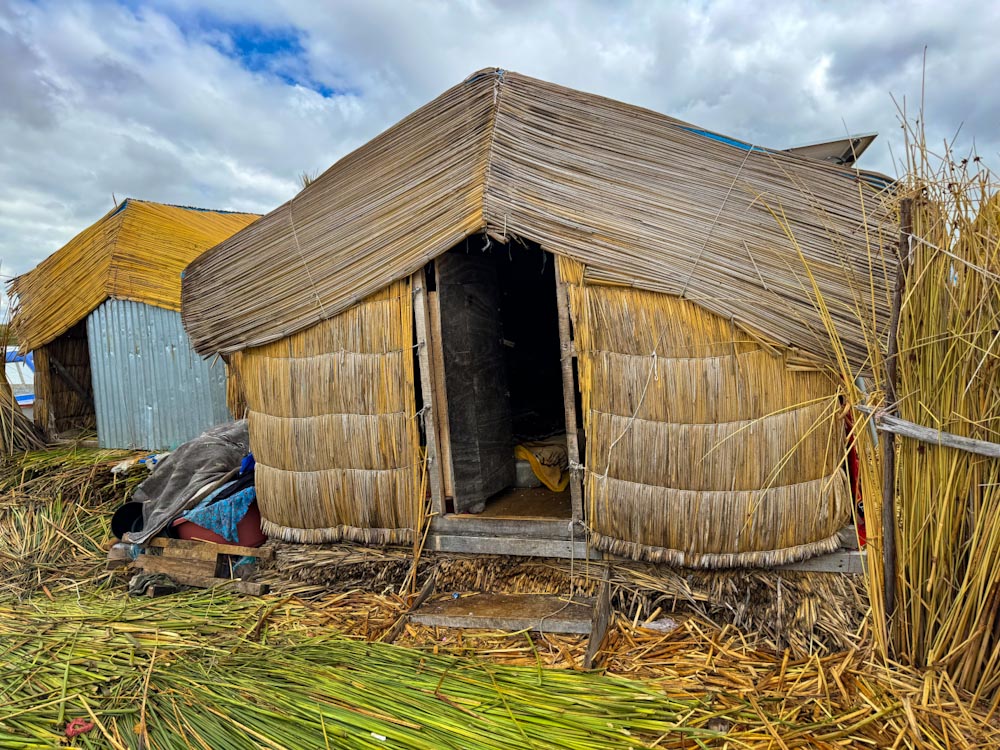
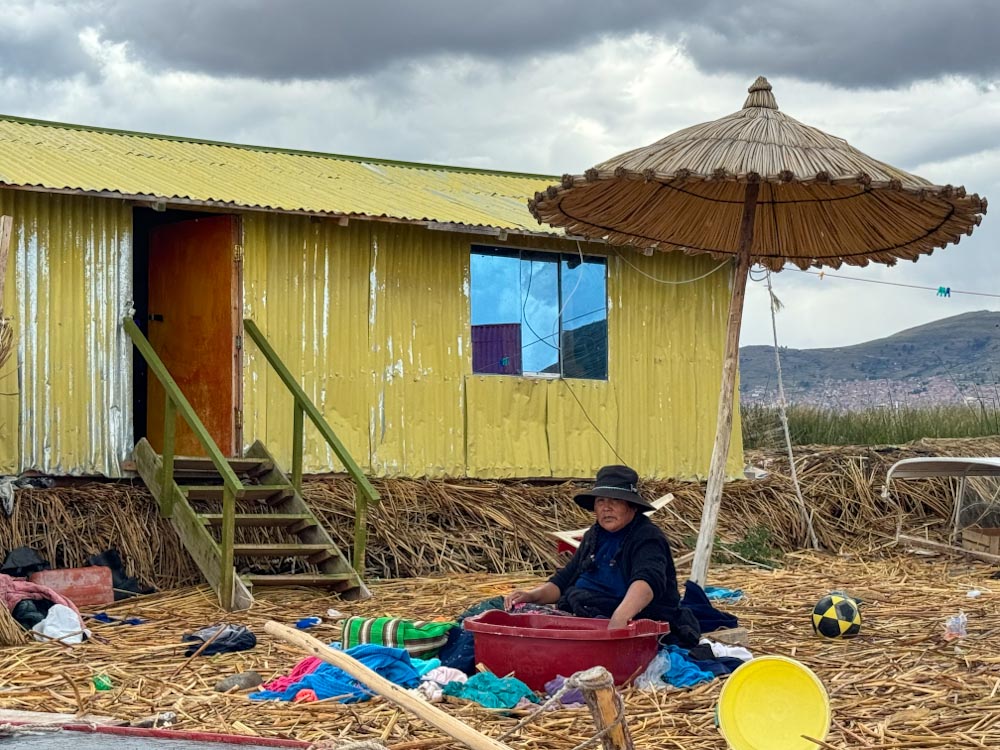
There are no windows. Almost all the space is taken up by a reed platform-bed, with warm blankets spread out on it. Items are hung on the walls; they don’t have closets or other furniture. Overall, it’s quite cozy inside. Two adults and their children live in such a house, and there’s no personal space.
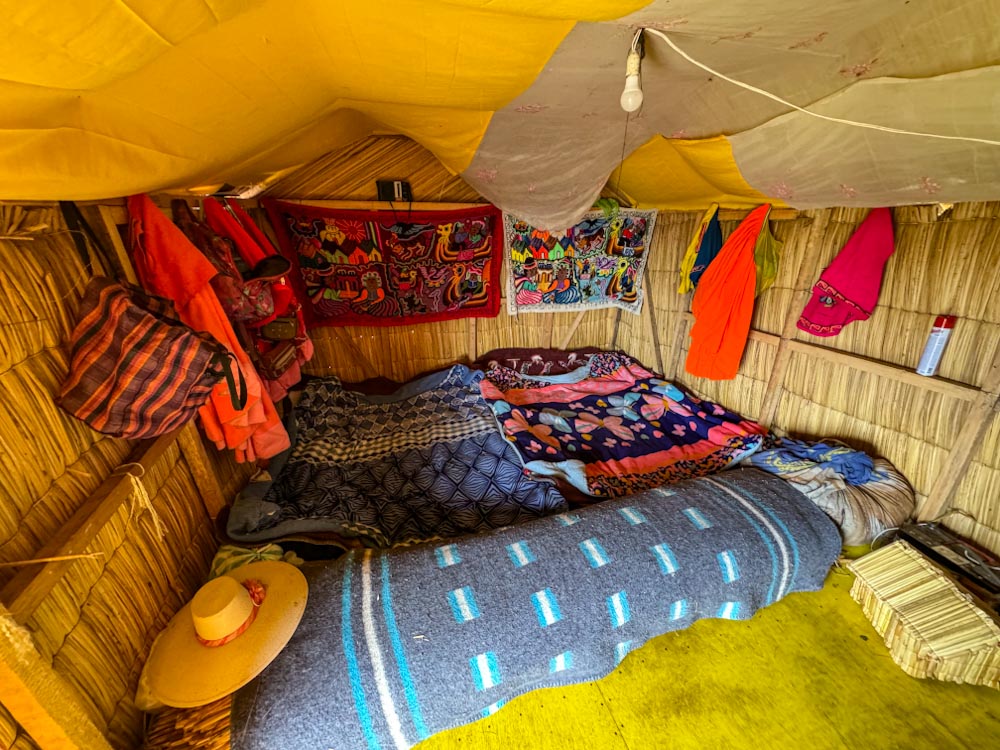
For tourists, houses with windows and full beds are built. Although it would be interesting to sleep on the reeds.
Where they cook food
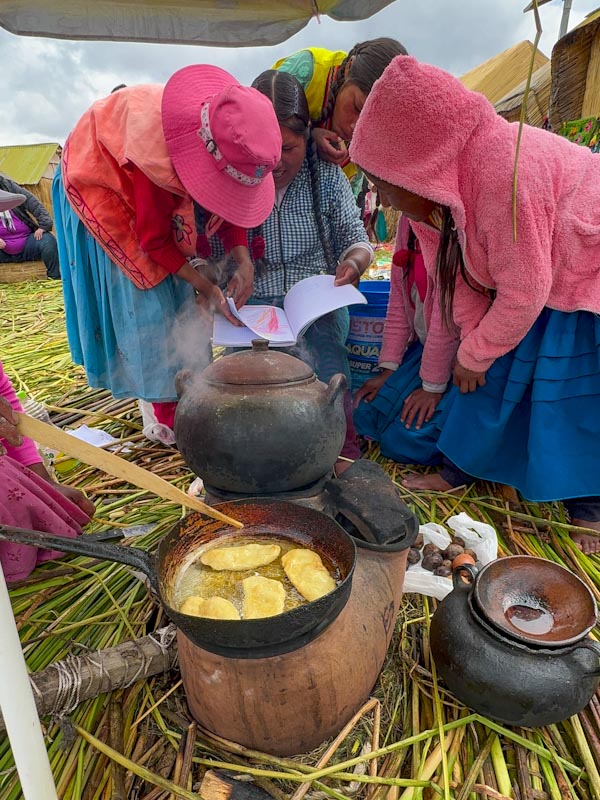
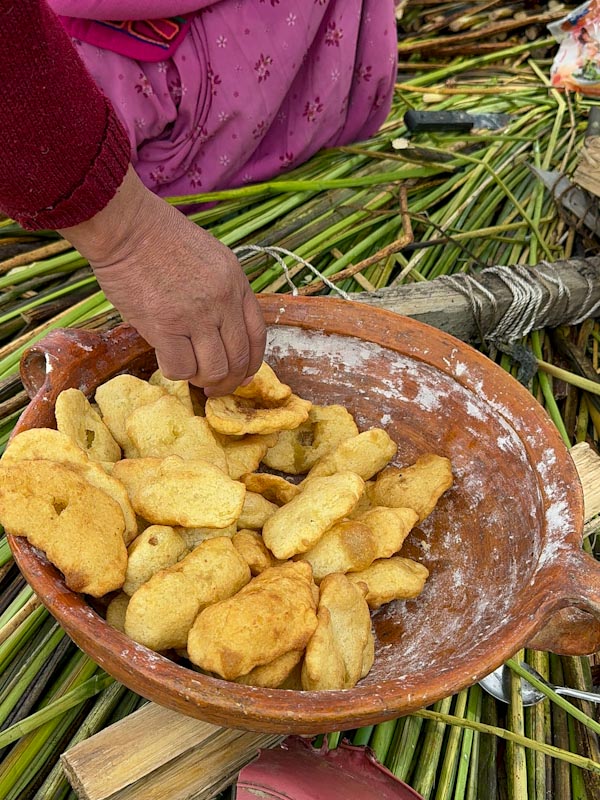
Food is cooked in a clay oven, which is always placed on a stone to prevent fires on the island. They don’t have a separate kitchen and cook open-air. But when the weather gets too bad, some modern families bust out a portable gas stove in their room.
Amenities on the reed islands
- Sanitation. Previously, Uru built separate “toilet” islands, which had to be reached by boat. Now these islands are tied to the main ones. They’re probably renovated more often than residential islands because they decay faster. The three-meter layer of reeds acts as a filter.
- Electricity from solar panels. Thanks to this, they can also heat water for showers since the lake water is icy.
- Water. Many drink water from the lake after boiling it. Previously, they drank it directly because the lake was cleaner. Other families buy drinking water in town.
- Internet. Since Uros is close to the city of Puno, they get phone signal there. No Starlink was spotted:)
Overall, life on Uros Island is not much different from my van life in the USA 😅
Uru Reed Boats

Residents of any islands can’t do without boats. Naturally, the Uru built their boats from the same reeds. They were simple and could fit two people.
The boats we see on the lake now—colorful, with the heads of some animals—are made for tourists. And modern residents of the floating islands use motorboats.
Typical food
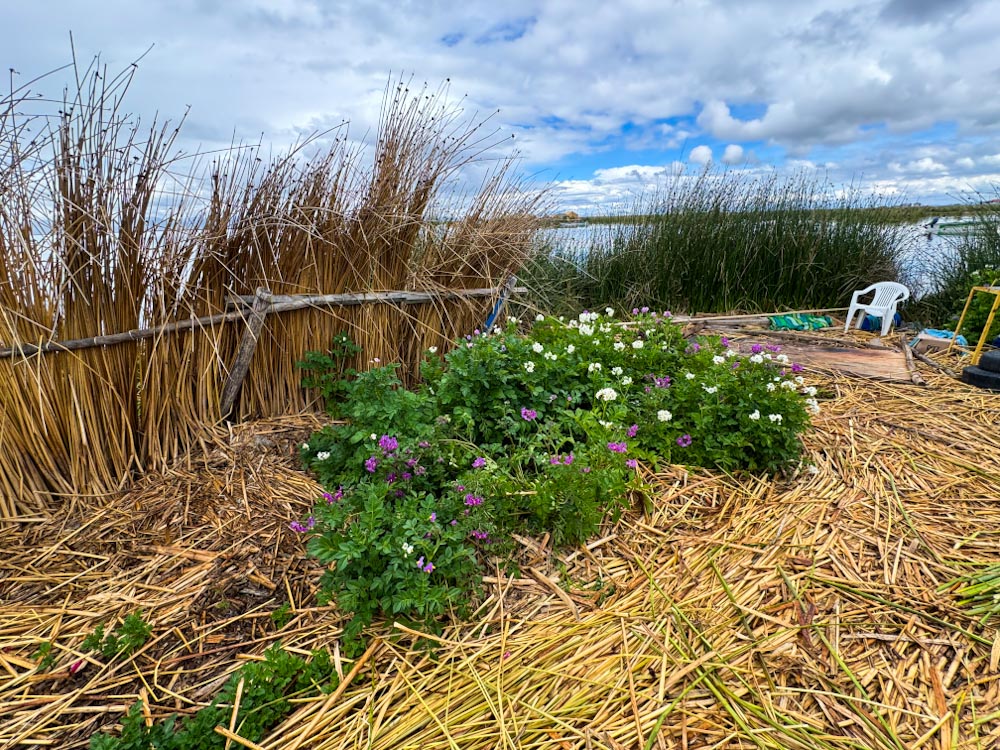
- The basis of the Uru’s diet is fish—which is expected. Previously, they caught “ispi”—small fish slightly larger than anchovies—and in 1940, trout was introduced into Lake Titicaca. The new species significantly harmed the lake’s ecosystem, but the people of Titicaca are happy—trout is much tastier and larger. Fun fact: Uru used to keep cormorants on a leash—birds that catch fish—and took their catch.
- Uru also hunted ducks, ibises, and even flamingos, and collected their eggs. The caught birds were sun-dried. Don’t worry, nobody eats flamingos anymore.
- They make liquor from totora reeds, and they eat the white part of reed called chullo —it’s rich in iodine, and they say it helps with hangovers. They made tea from the flowers of the reeds.
- There are some chickens on the islands now. But before they kept ibises instead of chickens for eggs and meat.
- They even planted potatoes on this island! The roots of the reeds contain enough nutrients to harvest a small crop.
Uros: Tourist Trap or a Disappearing Culture
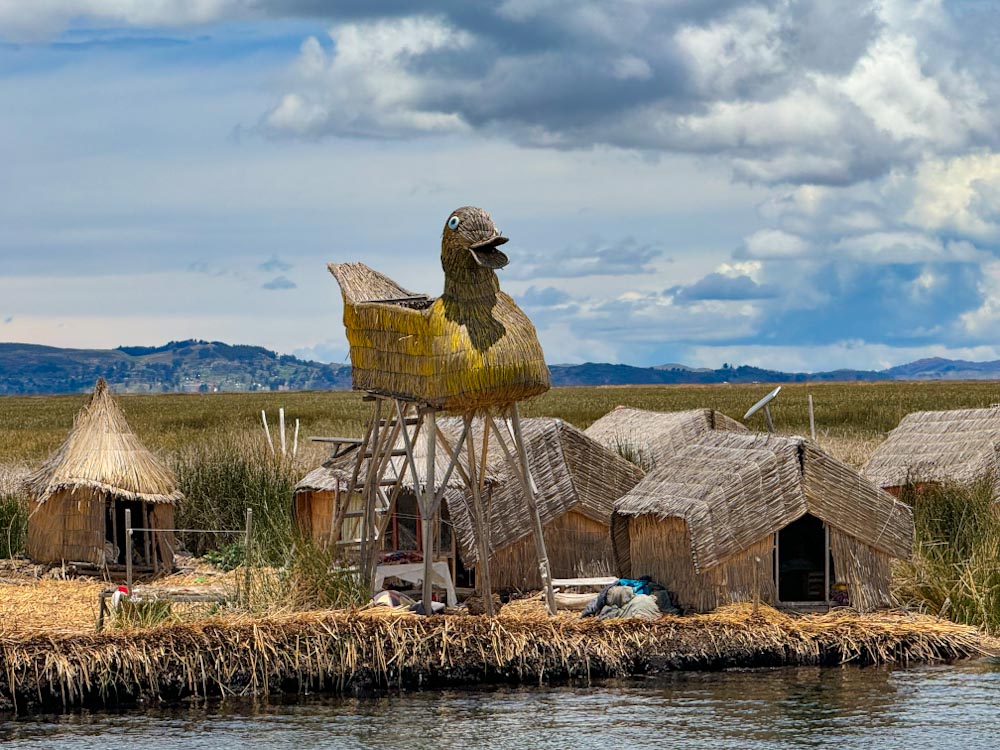
Tourism is the main hustle for the people of Uros. It allows them to keep their traditional way of life somewhat intact. Otherwise, they’d probably all move to the city, and we’d only hear about their reed islands in history books.
But there’s a downside to the local tourism scene. The reed islands have become one of Peru’s top attractions. Tour operators from Puno bring tourists by boat, but only a few splash out on pricey souvenirs, and even fewer stick around on floating islands overnight.
The Uros locals are like zoo animals on display. They go through the same show every day, and they don’t even get paid for it! They’re banking on selling their handicrafts at the end, but it’s a pretty sad sight.


